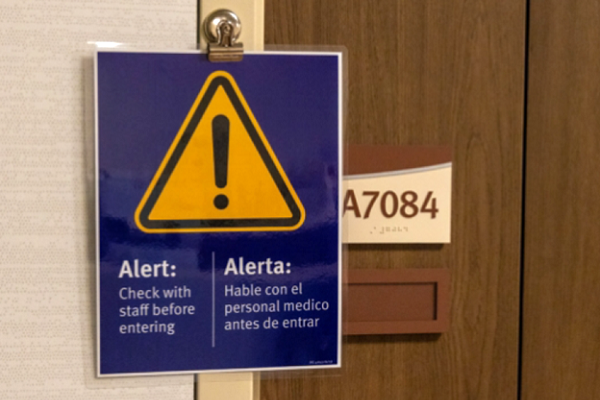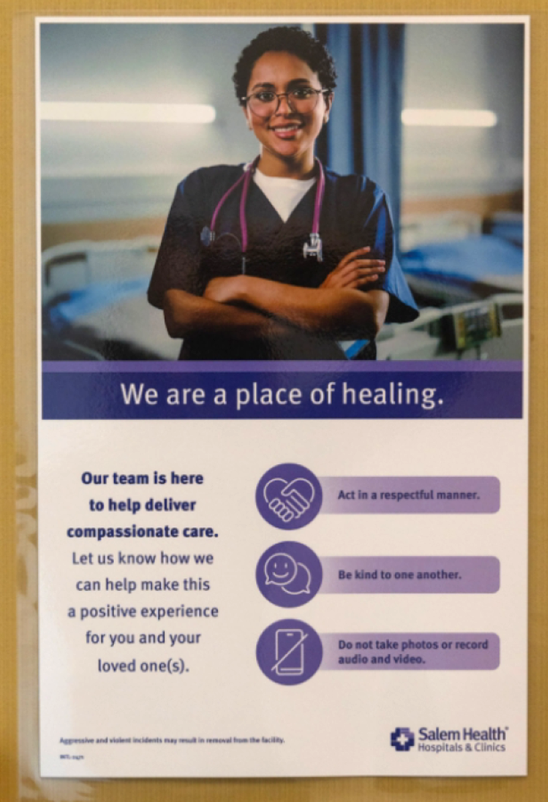
Workplace violence decreased by 21% thanks to education, action and collaboration
Oct 04, 2024
By fostering open communication, we reinforce that we are a place of healing, and we invite patients to engage with staff respectfully and participate in their care.
Salem Health saw a significant reduction in reported incidents of harmful words and actions in FY24, thanks to a comprehensive, collaborative approach.
Arthur Apodaca, employee safety program manager, and Aurora Commentz, IDEAL education manager, attribute the success to increased engagement and education among employees and patients, a strategy initiated in early 2023.
The Harmful Words and Actions training rolled out in February 2023. With a new reporting system and education — via signage, huddles and classes — it’s proven vital in addressing the pervasive issue of workplace violence. In fact, reported incidents have dropped a whopping 21% in the past year.
Teamwork makes the dream work
“It has taken a village and will continue to take a village,” Arthur said, emphasizing the importance of collective effort in fostering an environment where no patient or staff harm is acceptable.
“Historically, many employees knew about workplace violence but were unaware of how to report incidents or where to find support,” he said. “Now, we can walk into department meetings and most people raise their hands when asked if they know about Harmful Words and Actions.”
The engagement from staff has drastically increased, employees are becoming more familiar with the reporting system. This newfound awareness has empowered staff to report their experiences, ultimately contributing to a decline in incidents.
Enhancing patient experience
In addition to improving employee safety, the Harmful Words and Actions program is also focused on enhancing the patient experience.
“It’s important to set clear and mutual expectations for patients regarding acceptable behavior,” Arthur said.
Interestingly, it’s something they’ve heard from patient advocate teams: Patients want to know if they’re being mean or inappropriate.
“Patients want to know what's expected of them and they want to know when they cross the line,” Arthur said. “And I’ve found it very insightful when we are developing these tactics and strategies to include them in the conversation. By bringing them to the table with their families to say, ‘Look, this might be the problem, but we want to invite you into the conversation.’ Oh, turns out the patient now shares, ‘So I have terrible anxiety and I can’t control what comes out of my mouth. So, if you just make me less anxious, I won’t be such a jerk.’ Well, that’s great. I love that. Thanks for telling us.”

Once a patient’s care team knows the root cause of problematic behavior, they can take strides to help, like taking extra time to explain procedures to an anxious patient, Arthur said.
“You’re not pushing this person to a level of anxiety and feeling uncomfortable,” Arthur explained.
He emphasizes that while a patient’s anxiety might be the underlying reason they say harmful words to staff, it’s still not acceptable. However, by fostering open communication — just like the new signage in public areas aims to do — we reinforce that we are a place of healing, and we invite patients to engage with staff respectfully and participate in their care.
“By inviting our patients to be part of the conversation, we can better address their needs and ensure a safe healing environment for everyone,” Arthur said.
Reimagining care: Patient and Care Team Partnership Agreements
“We really want this to be about the patient,” Arthur said. “How are you helping us progress your care? How are you participating in your own care? How are you doing things so that we can move forward and not backward?”
The goal? Avoid hitting a “wall of care.” This could happen if the patient refuses care or if our staff are burning out. All these factors and more can start to surface, creating a standstill in care.
“That's when we start to see harm,” Arthur said. “Everything starts to kind of hit this wall at once, making it challenging to move forward.”
Turning walls into doors
Care team huddles can help providers and staff progress past a “wall of care.”
“A care team huddle can be initiated at any time by any staff member or provider,” Arthur said.
They include the registered nurses, the unit or divisional leadership, patient advocates, Harmful Words and Action team and care management. Some cases may also involve legal, Chief Nursing Officer and ethics, as needed.
“Everybody helps participate in the problem solving,” Arthur said. “When we have complex patient care situations, and we need to find a way to thoughtfully treat them, but there are barriers to those treatments, bringing this team together helps move forward and progress the much-needed care.”
Their stats prove it works.
“In an 18-month period, thanks to care team huddles, what we’ve found was there a 63% reduction in harm after the care team met,” Arthur said.
Reporting keeps everyone safer
Why should staff report harmful words and actions? After all, maybe it’s an older patient who reminds them of a grandparent, or has dementia or — giving the benefit of the doubt — didn’t really mean what they said?
Arthur hears these examples a lot. But it doesn’t mean anything that happened or was said was OK.
“Our staff are naturally caretakers, right?” he said. “And rightfully so. They're taught that in school from day one — I'm a caretaker, this is my patient.”
But while the patient’s diagnosis or their medical condition may be why they said it, Arthur said, it’s still unacceptable. Other members of the care team deserve to be warned when harm is a possibility.
“The Nurse who may be taking care of this patient tomorrow or the next day, or perhaps the employee who is walking by this patient’s room to deliver a meal tray? We must continue to communicate as a team — using tools such as the Harmful Words and Action visual alert signs helps break down silos.”
Ongoing challenges and future goals
While the reduction in reports is encouraging, Arthur and Aurora acknowledge that there is still work to be done. As they receive more data through reporting, they can better understand the underlying issues and focus problem solving on the areas that need it most.
The goal remains clear: To work toward eliminating incidents of harmful words and actions entirely.
“I would love to see zero someday,” Arthur said. “That might be a world different from the one we know now, but with ongoing collaboration, I believe we can achieve it, paving the way for an even safer workplace for our future employees.”
Learn more
Our Harmful Words and Actions program was featured in The Joint Commission’s July 2024 issue of EC News.